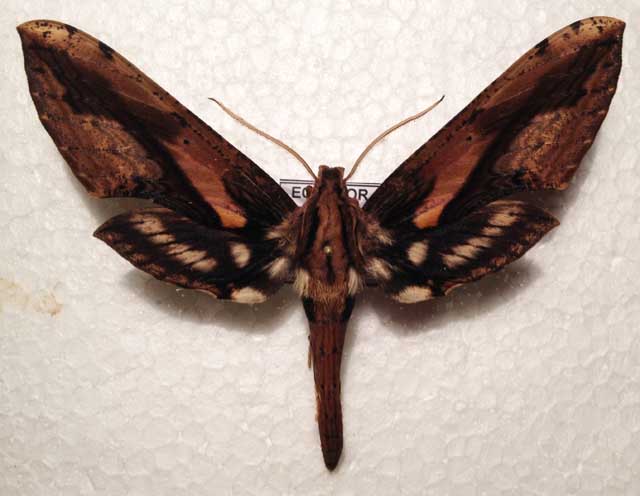Xylophanes lamontagnei
zail-AH-fan-eesmm
luh-MON-tayn-eye
Haxaire & Vaglia, 2007,

Xylophanes lamontagnei male, Rio Satipo, Junin, Peru,
courtesy of Mark Vincent.
This site has been created by
Bill Oehlke at oehlkew@islandtelecom.com
Comments, suggestions and/or additional information are welcomed by Bill.
TAXONOMY:
Family: Sphingidae, Latreille, 1802
Subfamily: Macroglossinae, Harris, 1839
Tribe: Macroglossini, Harris, 1839
Genus: Xylophanes Hubner [1819] ...........
Species: lamontagnei Haxaire & Vaglia, 2007
|
MIDI MUSIC
.....It's a Wonderful World.....
copyright C. Odenkirk
ON.OFF
<bgsound src="world.mid" LOOP=FOREVER>
|
DISTRIBUTION:
Xylophanes lamontagnei moths (wingspan: males: 92mm - females: 109mm)
fly in
Venezuela;
Ecuador: Morona Santiago (VK); and
Peru: Junin; Pasco: Oxapampa (VK)

Xylophanes lamontagnei male, 92mm,
Oxapampa, Pasco, Peru, courtesy of Vadim Kroutov.
Mark Vincent writes, "This species is easily distinguished from X. ceratomioides by the cream coloured hindwing postmedian band which,
unlike ceratomioides, is separated by dark lines along the veins into distinct lunules."
FLIGHT TIMES:
ECLOSION:
Pupae probably wiggle to surface from subterranean chambers or leaf litter just prior to
eclosion.
SCENTING AND MATING:Females call in the males with a pheromone released from a gland at the tip of the
abdomen. Males come in to lights very readily, but females are seldom taken in that way.

Xylophanes lamontagnei female, 109mm,
Morona Santiago, Ecuador, courtesy of Vadim Kroutov.
EGGS, LARVAE, PUPAE:
Use your browser "Back" button to return to the previous page.
Goto Main Sphingidae Index
Goto Macroglossini Tribe
Goto Central American Indices
Goto Carribean Islands
Goto South American Indices
Goto U.S.A. tables
The pronunciation of scientific names is
troublesome for many. The "suggestion" at the top of the page is
merely a suggestion. It is based on commonly
accepted English pronunciation of Greek names and/or some
fairly well accepted "rules" for latinized scientific names.
The suggested pronunciations, on this page and on other pages,
are primarily put forward to assist those who hear with internal
ears as they read.
There are many collectors from different countries whose
intonations and accents would be different.
Jean Marie Cadiou writes, "When I say "Xylophanes" in English I
pronounce it something like "Zailophanees", with the emphasis on the
"o". The French pronounce it differently, something like
"Kzeelophaness" with no emphasis, and the Germans yet in a
different way..."
"Xylophanes" sounds like it is from Greek mythology.
The species name, "lamontagnei" is honorific for La Montagne.
Use your browser "Back" button to return to the previous page.
This page is brought to you by
Bill Oehlke and the
WLSS. Pages are on space rented from Bizland. If you would like
to become a "Patron of the Sphingidae Site", contact Bill.
Please send sightings/images to Bill. I will do my best to respond to
requests for identification help.
Enjoy one of nature's wonderments: Live
Saturniidae (Giant Silkmoth) cocoons.
 | 
Show appreciation for this site by clicking on flashing butterfly to the left.
The link will take you to a page with links to many insect sites. |




